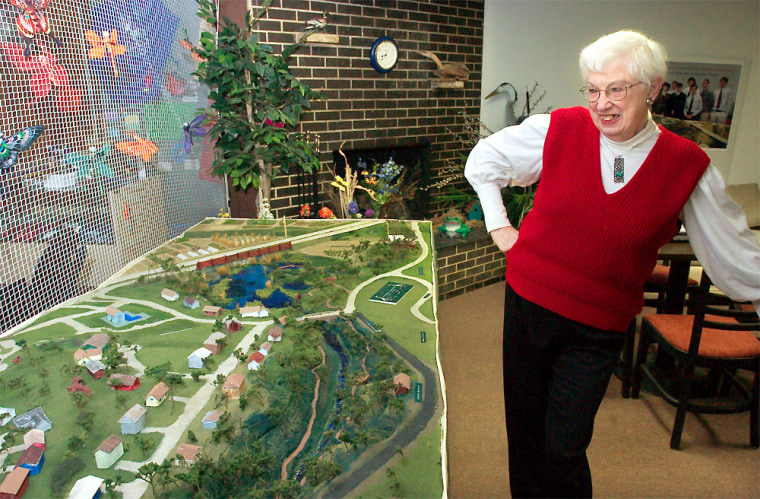Among the tangle of highways, strip malls and housing developments on the outskirts of town lies a snow-covered tract of 25 acres that in the spring blossoms into a lush wetland home to herons, mink and muskrats.
Opened to the public in 1999, the Heron Haven once served as an unofficial garbage dump. And its squat, brick education center was once a bar.
The turnaround came after the Audubon Society of Omaha officially became managers of the land in 1995. With federal, state and local donations, the chapter constructed a levee to control water levels and built a boardwalk that today brings visitors out into the prime wildlife viewing area of the wetland.
The success of restoration projects like Heron Haven is proof, say Audubon’s local members, that chapters aren’t just about bird watching. Around the nation, members see themselves as key activists and an essential part of keeping the national Audubon office in touch with issues on the homefront.
Ione Werthman, a member of the Omaha chapter for 30 years and a member on the national Audubon board, is part of a pocket of dissent among the local ranks of the Audubon. The dissenters contend the organization, established about a century ago by concerned bird enthusiasts, seems to have lost interest in grass-roots work.
Werthman recalls the days when national Audubon fought alongside local chapters to help Nebraska’s Niobrara River become a national scenic river in 1991 and to protect the critical bird habitat along the Platte River by stopping the Two Forks Dam upriver in Colorado in the 1980s.
In her opinion, that kind of partnership has faded.
“I think they’re lacking — now that we haven’t had any input, or any help, or any suggestion, any guidance from national on the Missouri River, which is a hot topic. And that’s just Nebraska,” Werthman said.
Nationwide movement
Members around the country established the Take Back Audubon movement about a year ago to give voice to such grievances.
Although the group is small — about 129 local chapters and 51 independent members out of the organization’s 550,000 members and 500 chapters — it isn’t being ignored on the national level, said John Bianchi, spokesman for the national Audubon in New York.
He contends the national group’s focus has not changed.
“Any group that has 550,000 members you will find that there are usually small groups of people who don’t agree with the direction the entire organization is going. I don’t think you can avoid that,” Bianchi said.
Chuck Bragg, a member of the Santa Monica Bay, Calif., chapter of the Audubon since 1977, has helped spearhead the Take Back Audubon movement. He said 90 percent of what the Audubon is doing is positive.
“But where we’re going is where chapters won’t matter,” he said.
At the top of the group’s list of complaints is the lack of communication between the national office and Audubon chapters — on topics ranging from guidance on the latest conservation issues in some areas to nationwide changes in the organization.
Debate over dues
Among those changes is a decision about three years ago to cut dues sharing to local chapters.
“For many chapters the money’s not important. It’s the significance of the step,” said Bragg, noting that rural chapters will, however, be hard hit by the loss.
Bianchi responded that one problem for the national office is that the $20 price of dues hasn’t kept pace with the cost of recruiting new members. “There is simply no dues to kick back,” he said.
In January, due in part to a push from Take Back Audubon, the national board agreed to extend a “safety net” of dues shares from July 2004 to July 2005.
But that money would be distributed through state Audubon offices, which introduces another rub, Werthman said, because a number of chapters don’t feel supported by their state offices.
Other concerns
One point of conflict has been the nature education centers the state offices run on behalf of the national Audubon. In its 1995 strategic plan, national Audubon launched a push to establish 1,000 of the centers by 2020.
“But what they seem to be doing is building some of their own grass roots,” said Darrel Whipple, an Audubon member for 29 years with the Willapa Hills chapter in Oregon.
Whipple, like others, is concerned that chapters don’t have a large enough role in the state-run centers.
Earmarking too much money for education and possibly not enough for conservation is another concern, Werthman said.
The Iain Nicolson Audubon Center in Gibbon, for instance, cost a little more than $1 million to build. Of the 40 or so nature centers around the country, the center is a shining star — treating visitors to front row seats as 600,000 migrating cranes touch down in the Platte River in the early spring.
Don Helmuth, director of Audubon’s Nebraska office, said the center and another under development in Denton have enabled the office to reach 8,000 students with educational programs.
“So what we’re doing with centers is we’re trying to help develop the researchers, the scientists, the environmental interest folk and the conservationists of the future,” said Helmuth, noting the center depends on hundreds of volunteers, including chapter members.
In spite of the discord, it appears the two sides are approaching common ground.
Though he said he couldn’t be specific, Bianchi noted that some of the key points Take Back Audubon presented at the January board meeting will be voted on at the next meeting in May.
Werthman is hopeful and believes the ideas of Take Back Audubon — such as better communication, a stronger partnership and settling the dues issue — have a chance like never before.
But there’s still work to do and Take Back Audubon has to keep pushing, she said. “There’s always got to be someone who’s stirring the waters.”
